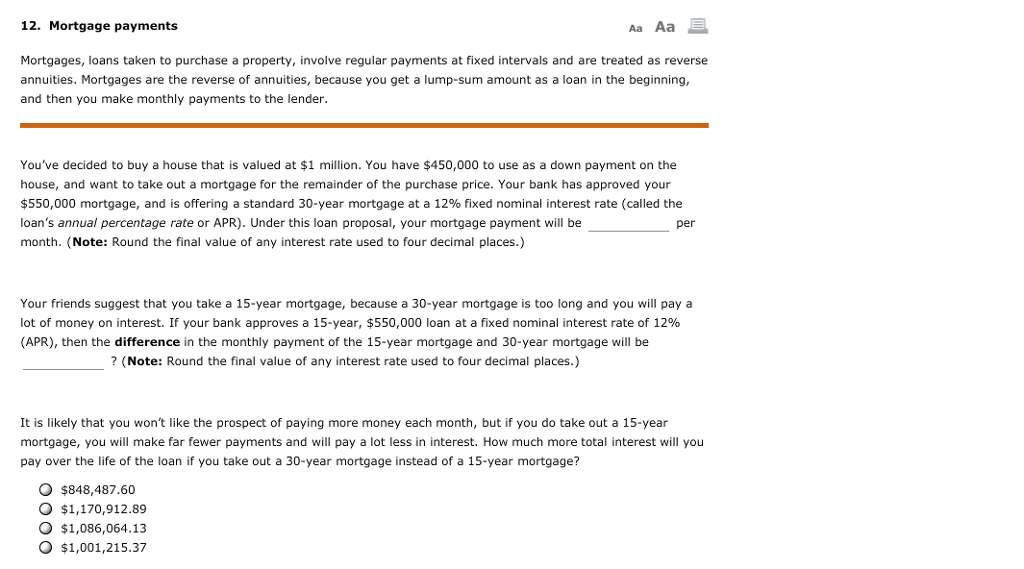Table of ContentsLittle Known Facts About Why Are Reverse Mortgages A Bad Idea.All About What Is Required Down Payment On MortgagesAll About Why Do Banks Sell MortgagesThe Ultimate Guide To Why Do Banks Sell Mortgages To Fannie MaeThe Only Guide to How To Shop For Mortgages
A mortgage is likely to be the biggest, longest-term loan you'll ever take out, to buy the greatest property you'll ever own your house. The more you comprehend about how a home mortgage works, the much better choice will be to select the home mortgage that's right for you. In this guide, we will cover: A home loan is a loan from a bank or lending institution to assist you finance the purchase of a house.
The home is used as "collateral." That means if you break the pledge to repay at the terms developed on your home mortgage note, the bank can foreclose on your home. Your loan does not become a home loan till it is attached as a lien to your home, indicating your ownership of the home ends up being subject to you paying your new loan on time at the terms you concurred to.
The promissory note, or "note" as it is more typically labeled, details how you will pay back the loan, with information consisting of the: Interest rate Loan quantity Term of the loan (thirty years or 15 years are common examples) When the loan is considered late What the principal and interest payment is.
The home mortgage basically gives the lending institution the right to take ownership of the property and offer it if you don't make payments at the terms you accepted on the note. Many home mortgages are contracts in between two parties you and the loan provider. In some states, a 3rd individual, called a trustee, might be contributed to your home mortgage through a document called a deed of trust.
How What Are Reverse Mortgages can Save You Time, Stress, and Money.
PITI is an acronym lending institutions utilize to describe the different parts that make up your regular monthly home mortgage payment. It represents Principal, Interest, Taxes and Insurance coverage. In the early years of your home loan, interest makes up a majority of your total payment, but as time goes on, you begin paying more principal than interest till the loan is paid off.
This schedule will reveal you how your loan balance drops over time, as well as how much principal you're paying versus interest. Homebuyers have a number of alternatives when it pertains to selecting a home mortgage, however these choices tend to fall into the following three headings. One of your very first choices is whether you want a fixed- or adjustable-rate loan.
In a fixed-rate mortgage, the rate of interest is set when you get the loan and will not alter over the life of the mortgage. Fixed-rate mortgages provide stability in your home mortgage payments. In a variable-rate mortgage, the rate of interest you pay is connected to an index and a margin.
The index is a procedure of worldwide rates of interest. The most frequently used are the one-year-constant-maturity Treasury securities, the Expense of Funds Index (COFI), and the London Interbank Offer Rate (LIBOR). These indexes comprise the variable part of your ARM, and can increase or decrease depending on factors such as how the economy is doing, and whether the Federal Reserve is increasing or decreasing rates.
Excitement About What Credit Score Do Banks Use For Mortgages
After your preliminary set rate duration ends, the loan provider will take the present index and the margin to determine your new rates of interest. The quantity will change based upon the adjustment duration you selected with your adjustable rate. with a 5/1 ARM, for instance, the 5 represents the number of years your preliminary rate is fixed and won't change, while the 1 represents how often your rate can change after the set period is over so every year after the fifth year, your rate can change based on what the index rate is plus the margin.
That can mean substantially lower payments in the early years of your loan. Nevertheless, keep in mind that your scenario might change before the rate change. If interest rates increase, the worth of your residential or commercial property falls or your monetary condition modifications, you might not have the ability to sell the house, and you might have difficulty paying based upon a higher rates of interest.
While the 30-year loan is often picked because it provides the least expensive month-to-month payment, there are terms ranging from 10 years to even 40 years. Rates on 30-year home loans are greater than much shorter term loans like 15-year loans. Over the life of a shorter term loan like a 15-year or 10-year loan, you'll pay considerably less interest.
You'll also require to choose whether you want a government-backed or standard loan. These loans are insured by the federal government. FHA loans are assisted in by the Department of Real Estate and Urban Advancement (HUD). They're created to assist first-time homebuyers and individuals with low incomes or little savings pay for a home.
Unknown Facts About How Do Lenders Make Money On Reverse Mortgages
The disadvantage of FHA loans is that they need an in advance mortgage insurance coverage charge and regular monthly home mortgage insurance payments for all purchasers, despite your down payment. And, unlike traditional loans, the home loan insurance coverage can not be canceled, unless you made at least a 10% deposit when you took out the initial FHA mortgage.
HUD has a searchable database where you can discover lending institutions in your location that use FHA loans. The U.S. Department of Veterans Affairs provides a home loan program for military service members and their households. The advantage of VA loans is that they may not require a down payment or mortgage insurance coverage.

The United States Department of Farming (USDA) offers a loan program for homebuyers in rural areas who satisfy certain income requirements. Their property eligibility map can give you a general concept of certified locations. USDA loans do not require a deposit or continuous mortgage insurance coverage, but debtors need to pay an upfront charge, which currently stands at 1% of the purchase rate; that fee can be financed with the mortgage.
A conventional home mortgage is a home mortgage that isn't guaranteed or guaranteed by the federal government and adheres to the loan limitations stated by Fannie Mae and Freddie Mac. For debtors with greater credit history and steady earnings, traditional loans often result in the most affordable monthly payments. Generally, standard loans have actually needed larger deposits than most federally backed loans, but the Fannie Mae HomeReady and Freddie Mac HomePossible loan programs now provide customers a 3% down alternative which is lower than the 3.5% minimum needed by FHA loans.

How To Sell Mortgages Can Be Fun For Everyone
Fannie Mae and Freddie Mac are federal government sponsored business (GSEs) that purchase and offer mortgage-backed securities. Conforming loans meet GSE underwriting standards and fall within their maximum loan limitations. For a single-family home, the loan limit is presently $484,350 for a lot of houses in the contiguous states, the District of Columbia and Puerto Rico, and $726,525 for houses in higher expense locations, like Alaska, Hawaii and numerous U - when to refinance mortgages.S.
You can look up your county's limitations here. Jumbo loans might likewise be referred to as nonconforming loans. Simply put, jumbo loans exceed the loan limits established by Fannie Mae and Freddie Mac. Due to their size, jumbo loans represent a higher risk for the lending institution, so customers need to usually have strong credit history and make larger down payments.